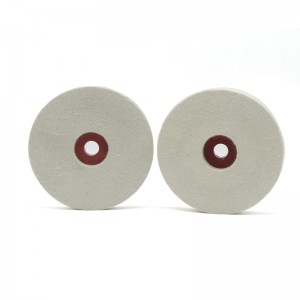In the dynamic landscape of modern manufacturing and craftsmanship, wool felt wheels are emerging as a catalyst for cross – industry technological convergence. These unassuming yet versatile tools are bridging the gap between different sectors, facilitating the exchange of innovative techniques and the development of hybrid applications.
The integration of wool felt wheels in the electronics and textile industries exemplifies this trend. In electronics manufacturing, where precision is paramount, wool felt wheels are being employed for the delicate polishing of circuit board components. Their soft and fine – textured surfaces ensure that sensitive electronic parts are not damaged during the finishing process. Meanwhile, in the textile industry, wool felt wheels are used for the surface treatment of high – end fabrics. By combining the knowledge of material science from both fields, engineers are developing new types of wool felt wheels with enhanced static – resistance properties, making them suitable for handling electrostatic – sensitive electronic components while also maintaining their effectiveness in textile finishing. This cross – pollination of ideas has led to the creation of specialized wool felt wheels that can serve dual purposes, reducing the need for multiple tools and streamlining production processes.
The automotive and art industries are also experiencing the benefits of technological convergence through wool felt wheels. In automotive design, custom – made wool felt wheels are being used to create unique textures on vehicle interiors, adding a touch of artistry to mass – produced cars. At the same time, artists are drawing inspiration from the automotive industry’s precision – manufacturing techniques to use wool felt wheels in large – scale sculptures. The collaboration between these two seemingly disparate industries has given rise to innovative surface – finishing methods, such as using automotive – grade polishing compounds with wool felt wheels in art installations to achieve a long – lasting, high – gloss finish. This convergence not only enriches the creative possibilities but also opens up new markets for wool felt wheel manufacturers.
Furthermore, the medical and jewelry industries are exploring joint solutions with wool felt wheels at the core. In medical jewelry, which is designed for patients with specific health needs, wool felt wheels are used to ensure a smooth and comfortable finish on wearable devices. The shared focus on precision and biocompatibility in both sectors has led to the development of wool felt wheels made from hypoallergenic and sterilizable materials. These wheels can be used interchangeably in the production of medical implants and high – end medical – themed jewelry, showcasing the potential of cross – industry collaboration to drive innovation in material science and manufacturing processes.
As industries continue to seek ways to differentiate themselves and improve efficiency, the role of wool felt wheels in driving cross – industry technological convergence will only become more significant. This trend is not only reshaping the way these tools are used but also fostering a new era of collaborative innovation across diverse sectors.

Post time: Jun-12-2025
